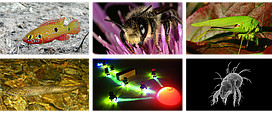Publikationen
Ausgewählte Publikationen
Chafino S, López-Escardó D, Benelli G, Kovac H, Casacuberta E, Franch-Marro X, Kathirithamby J, Martín D 2018. Differential expression of the adult specifier E93 in the strepsipteran Xenos vesparum Rossi suggests a role in female neoteny. Sci Rep 8, 14176.
doi:10.1038/s41598-018-32611-y
Kovac H, Käfer H, Stabentheiner A 2018. The energetics and thermoregulation of water collecting honeybees. J Comp Physiol A 204, 783-790.
doi:10.1007/s00359-018-1278-9
Kovac H, Stabentheiner A, Brodschneider R 2018. Foraging strategy of wasps – optimisation of intake rate or energetic efficiency? J Exp Biol 221, jeb174169.
dx.doi.org/10.1242/jeb.174169
Erregger B, Kovac H, Stabentheiner A, Hartbauer M, Römer H, Schmidt A K D 2017. Cranking up the heat: relationships between energetically costly song features and the increase in thorax temperature in male crickets and katydids. J Exp Biol 220, 2635-2644.
dx.doi.org/10.1242/jeb.155846
Kovac H, Käfer H, Petrocelli I, Stabentheiner A 2017. Comparison of thermal traits of Polistes dominula and Polistes gallicus, two European paper wasps with strongly differing distribution ranges. J Comp Physiol B 187, 277-290.
http://dx.doi.org/10.1007/s00360-016-1041-x
Stabentheiner A, Kovac H 2016. Honeybee economics: optimisation of foraging in a variable world. Sci Rep 6, 28339.
http://www.nature.com/articles/srep28339
Käfer H, Kovac H, Oswald B, Stabentheiner A 2015. Respiration and metabolism of the resting European paper wasp (Polistes dominulus). J Comp Physiol B 185, 647-658.
http://dx.doi.org/10.1007/s00360-015-0915-7
Kovac H, Stabentheiner A, Brodschneider R 2015. What do foraging wasps optimize in a variable environment, energy investment or body temperature? Journal of Comparative Physiology A 201, 1043-1052.
http://dx.doi.org/10.1007/s00359-015-1033-4
Stabentheiner A, Kovac H 2014. Energetic optimisation of foraging honeybees: flexible change of strategies in response to environmental challenges. Plos One 9, e105432.
http://dx.doi.org/10.1371/journal.pone.0105432
Kovac H, Käfer H, Stabentheiner A, Costa C 2014. Metabolism and upper thermal limits of Apis mellifera carnica and A. m. ligustica. Apidologie 45, 664-677.
http://dx.doi.org/10.1007/S13592-014-0284-3
Käfer H, Kovac H, Stabentheiner A 2013. Respiration patterns of resting wasps (Vespula sp.). Journal of Insect Physiology 59, 475-486.
http://dx.doi.org/10.1016/j.jinsphys.2013.01.012
Kovac H & Stabentheiner A 2012. Does size matter? - Thermoregulation of ‘heavyweight’ and ‘lightweight’ wasps (Vespa crabro and Vespula sp.). Biology Open 1, 848-856.
http://bio.biologists.org/content/1/9/848.full.pdf+html
Stabentheiner A, Kovac H, Hetz S K, Käfer H, Stabentheiner G 2012. Assessing honeybee and wasp thermoregulation and energetics – new insights by combination of flow-through respirometry with infrared thermography. Thermochimica Acta 534, 77-86.
http://dx.doi.org/10.1016/j.tca.2012.02.006
Käfer H, Kovac H, Stabentheiner A 2012. Resting metabolism and critical thermal maxima of vespine wasps (Vespula sp.). Journal of Insect Physiology 58, 679-689.
http://dx.doi.org/10.1016/j.jinsphys.2012.01.015
Kovac H & Stabentheiner A 2011. Thermoregulation of foraging honeybees on flowering plants: seasonal variability and influence of radiative heat gain. Ecological Entomology 36, 686-699.
http://onlinelibrary.wiley.com/doi/10.1111/j.1365-2311.2011.01313.x/pdf
Kovac H, Stabentheiner A & Schmaranzer S 2010. Thermoregulation of water foraging honeybees – balancing of endothermic activity with radiative heat gain and functional requirements. Journal of Insect Physiology 56, 1834-1845.
http://dx.doi.org/10.1016/j.jinsphys.2010.08.002
Stabentheiner A, Kovac H & Brodschneider R 2010. Honeybee colony thermoregulation – regulatory mechanisms and contribution of individuals in dependence on age, location and thermal stress. Plos ONE 5, e8967.
http://dx.plos.org/10.1371/journal.pone.0008967
Kovac H, Stabentheiner A & Schmaranzer S 2009. Thermoregulation of water foraging wasps (Vespula sp. and Polistes sp.). Journal of Insect Physiology 55, 959-966.
http://dx.doi.org/10.1016/j.jinsphys.2009.06.012
Kovac H, Stabentheiner A & Brodschneider R 2009. Contribution of honeybee drones of different age to colonial thermoregulation. Apidologie 40, 82-95.
DOI: 10.1051/apido/2008069
Kovac H, Stabentheiner A, Hetz K, Petz M & Crailsheim K 2007. Respiration of resting honeybees. Journal of Insect Physiology 53, 1250-1261.
http://dx.doi.org/10.1016/j.jinsphys.2007.06.019
Stabentheiner A, Kovac H & Schmaranzer S 2007. Thermal behaviour of honeybees during aggressive interactions. Ethology 113, 995-1006.
Stabentheiner A, Vollmann J, Kovac H & Crailsheim K 2003. Oxygen consumption and body temperature of active and resting honeybees. Journal of Insect Physiology 49, 881-889.
Stabentheiner A, Kovac H & Schmaranzer S 2002. Honeybee nestmate recognition: the thermal behaviour of guards and their examinees. Journal of Experimental Biology 205, 2637-2642.
Kovac H & Stabentheiner A 1999. Effect of food quality on the body temperature of wasps (Vespula vulgaris). Journal of Insect Physiology 45, 183-190.
Kovac H & Schmaranzer S 1996. Thermoregulation of Honeybees (Apis mellifera) Foraging in Spring and Summer at Different Plants. Journal of Insect Physiology 42, 1071-1076.
Stabentheiner A, Kovac H & Hagmüller K 1995. Thermal behavior of round and wagtail dancing honeybees. Journal of Comparative Physiology B 165, 433-444.
Kovac H & Crailsheim K 1988. Lifespan of Apis mellifera carnica Pollm. infested by Varroa jacobsoni OUD. in relation to season and extent of infestation. Journal of apicultural Research 27, 230-238.
Helmut Kovac
Institut für BiologieUniversität Graz
Universitätsplatz 2, 8010 Graz
Österreich
